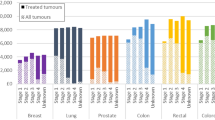Abstract
Purpose
The objective of the study was to validate the previously reported lookup Table and Bladder Cancer Research Consortium (BCRC) nomogram in predicting cancer-specific mortality (CSM) and all-cause mortality (ACM) after radical cystectomy using an external cohort from South Korea.
Methods
The study comprised 409 patients. Discrimination was quantified with the concordance index. The relationship between the model-derived and actual CSM and ACM was graphically explored within calibration plots. Clinical net benefit was evaluated by decision curve analysis.
Results
Of the 409 patients, 147 (35.9 %) had died from various causes. One hundred two deaths were attributable to bladder cancer. For CSM at 5 years, the bootstrap-corrected concordance indices of the American Joint Committee on Cancer (AJCC) staging system, lookup Table, and BCRC nomogram were 71.8 % (95 % confidence interval [CI] 66.9–76.5), 73.0 % (95 % CI 67.9–78.0), and 76.2 % (95 % CI 71.6–80.9), respectively. For ACM at the same time point, the discrimination accuracies of these models were 70.7 % (95 % CI 66.7–74.6), 72.8 % (95 % CI 68.5–76.9), and 76.2 % (95 % CI 72.3–80.2), respectively. The calibration plots tended to exaggerate both survival outcomes in all models. When compared to the lookup Table as well as the AJCC staging system, the BCRC nomogram performed well across a wide range of threshold probabilities using decision curve analysis.
Conclusions
The BCRC nomogram was characterized by higher accuracy and larger potential clinical benefit compared to the lookup Table. However, there is a great need for additional models that consider outcomes of patients for whom the existing models do not apply.



Similar content being viewed by others
References
Shariat SF, Karakiewicz PI, Palapattu GS, et al. Nomograms provide improved accuracy for predicting survival after radical cystectomy. Clin Cancer Res. 2006;12:6663–76.
Karakiewicz PI, Shariat SF, Palapattu GS, et al. Nomogram for predicting disease recurrence after radical cystectomy for transitional cell carcinoma of the bladder. J Urol. 2006;176:1354–61.
International Bladder Cancer Nomogram Consortium; Bochner BH, Kattan MW, Vora KC. Postoperative nomogram predicting risk of recurrence after radical cystectomy for bladder cancer. J Clin Oncol. 2006;24:3967–72.
Shariat SF, Karakiewicz PI, Ashfaq R, et al. Multiple biomarkers improve prediction of bladder cancer recurrence and mortality in patients undergoing cystectomy. Cancer. 2008;112:315–25.
el-Mekresh M, Akl A, Mosbah A, Abdel-Latif M, Abol-Enein H, Ghoneim MA, et al. Prediction of survival after radical cystectomy for invasive bladder carcinoma: risk group stratification, nomograms or artificial neural networks? J Urol. 2009;182:466–72.
Shariat SF, Chade DC, Karakiewicz PI, et al. Combination of multiple molecular markers can improve prognostication in patients with locally advanced and lymph node positive bladder cancer. J Urol. 2010;183:68–75.
Shariat SF, Chromecki TF, Cha EK, et al. Risk stratification of organ confined bladder cancer after radical cystectomy using cell cycle related biomarkers. J Urol. 2012;187:457–62.
Lughezzani G, Sun M, Shariat SF, et al. A population-based competing-risks analysis of the survival of patients treated with radical cystectomy for bladder cancer. Cancer. 2011;117:103–9.
Zaak D, Burger M, Otto W, et al. Predicting individual outcomes after radical cystectomy: an external validation of current nomograms. BJU Int. 2010;106:342–8.
Nuhn P, May M, Sun M, et al. External validation of postoperative nomograms for prediction of all-cause mortality, cancer-specific mortality, and recurrence in patients with urothelial carcinoma of the bladder. Eur Urol. 2012;61:58–64.
Bassi PF, Bongiovanni L, Racioppi M, et al. Postoperative nomogram for invasive bladder cancer: does it really work? A multicenter cohort study. Urol Oncol. 2011;29:698–702.
Steyerberg EW, Bleeker SE, Moll HA, Grobbee DE, Moons KG. Internal and external validation of predictive models: a simulation study of bias and precision in small samples. J Clin Epidemiol. 2003;56:441–7.
Harrell FE Jr, Lee KL, Mark DB. Multivariable prognostic models: issues in developing models, evaluating assumptions and adequacy, and measuring and reducing errors. Stat Med. 1996;15:361–87.
Heagerty PJ, Lumley T, Pepe MS. Time-dependent ROC curves for censored survival data and a diagnostic marker. Biometrics. 2000;56:337–44.
Vickers AJ, Elkin EB. Decision curve analysis: a novel method for evaluating prediction models. Med Decis Making. 2006;26:565–74.
Graefen M, Karakiewicz PI, Cagiannos I, et al. A validation of two preoperative nomograms predicting recurrence following radical prostatectomy in a cohort of European men. Urol Oncol. 2002;7:141–6.
Cindolo L, Patard JJ, Chiodini P, et al. Comparison of predictive accuracy of four prognostic models for nonmetastatic renal cell carcinoma after nephrectomy: a multicenter European study. Cancer. 2005;104:1362–71.
Kattan MW. Comparison of Cox regression with other methods for determining prediction models and nomograms. J Urol. 2003;170:S6–9.
Kattan MW. Nomograms are superior to staging and risk grouping systems for identifying high-risk patients: preoperative application in prostate cancer. Curr Opin Urol. 2003;13:111–6.
Chun FK, Karakiewicz PI, Briganti A, Walz J, Kattan MW, Huland H, Graefen M. A critical appraisal of logistic regression-based nomograms, artificial neural networks, classification and regression-tree models, look-up Tables and risk-group stratification models for prostate cancer. BJU Int. 2007;99:794–800.
Porter MP, Kerrigan MC, Donato BM, Ramsey SD. Patterns of use of systemic chemotherapy for Medicare beneficiaries with urothelial bladder cancer. Urol Oncol. 2011;29:252–8.
Shariat SF, Margulis V, Lotan Y, Montorsi F, Karakiewicz PI. Nomograms for bladder cancer. Eur Urol. 2008;54:41–53.
Nam RK, Kattan MW, Chin JL, et al. Prospective multi-institutional study evaluating the performance of prostate cancer risk calculators. J Clin Oncol. 2011;29:2959–64.
Disclosure
The authors declare no conflict of interest.
Author information
Authors and Affiliations
Corresponding author
Appendix
Appendix
Distribution of model predictions with each AJCC staging system. a The look-up table predicted probability of 5-year cancer-specific mortality. b Bladder Cancer Research Consortium nomogram predicted probability of 5-year cancer-specific mortality. c The look-up table predicted probability of 5-year all-cause mortality. d Bladder Cancer Research Consortium nomogram predicted probability of 5-year all-cause mortality
Rights and permissions
About this article
Cite this article
Moon, K.C., Kim, M., Kwak, C. et al. External Validation of Online Predictive Models for Prediction of Cancer-specific Mortality and All-cause Mortality in Patients with Urothelial Carcinoma of the Urinary Bladder. Ann Surg Oncol 21, 3132–3141 (2014). https://doi.org/10.1245/s10434-014-3561-5
Received:
Published:
Issue Date:
DOI: https://doi.org/10.1245/s10434-014-3561-5





